Opportunity Solution Trees
Navigating the tangled web of opportunities in product discovery can be overwhelming, but this framework provides a clear visual framework to map desired outcomes to key opportunities and potential solutions.
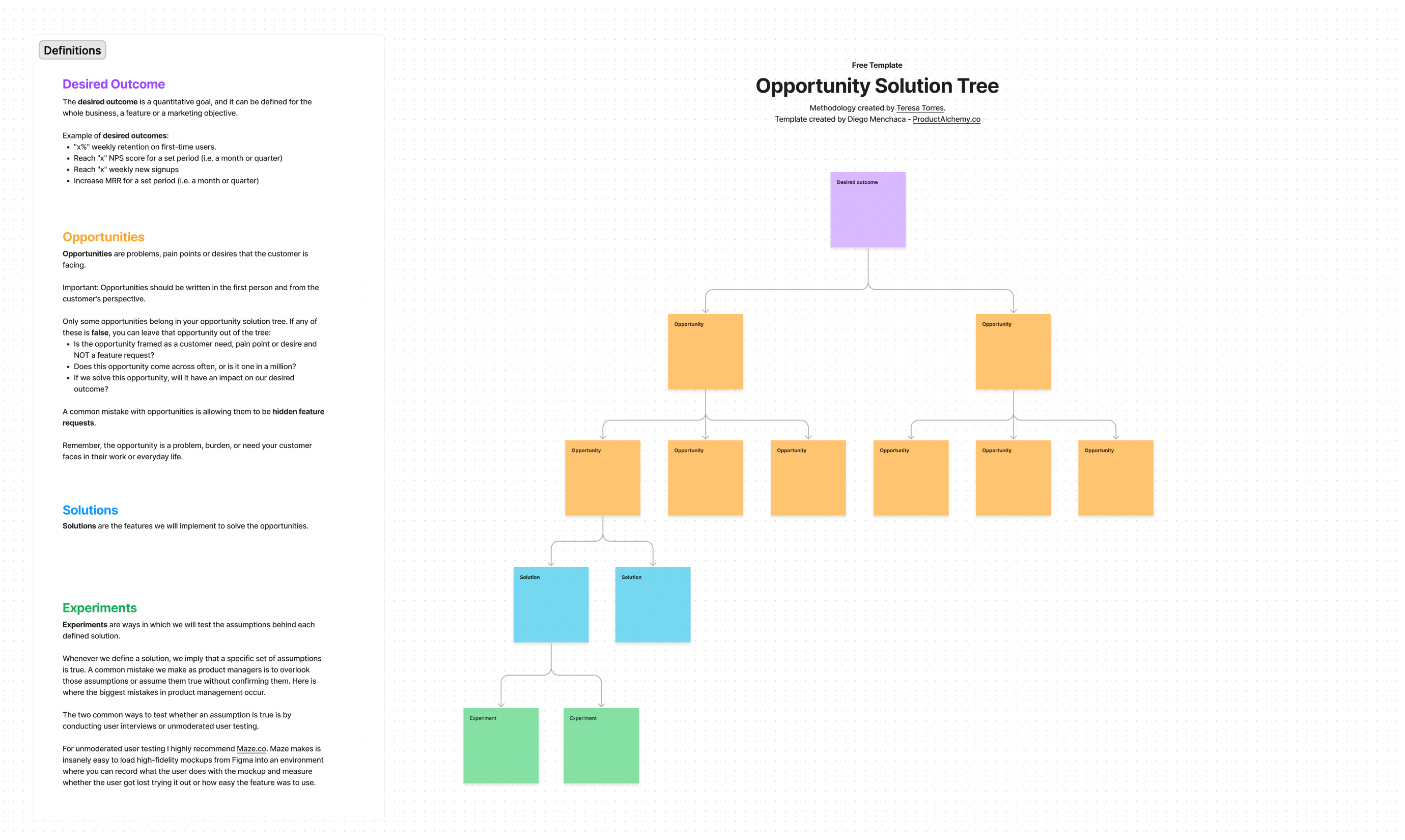
Unlocking the Power of Opportunity Solution Trees in 2023
Amid the tangled web of product opportunities, how can teams identify the most promising possibilities?
When a myriad of solution paths branch out before you, which route leads to meaningful results?
Product discovery often feels like wandering aimlessly through a dense forest, but what if there was a map to guide your way?
Enter the Opportunity Solution Tree (OST), an innovative new framework designed to illuminate the intricate terrain of opportunities and empower teams to take the optimal path to innovative solutions.
Like a lighthouse shining through fog, OSTs help teams navigate complexity, align strategically, and deliver genuine value to customers. Read on to uncover how this breakthrough visual methodology can transform product discovery from a meandering hike into a focused journey to your destination.
With OSTs, you’ll watch the fog lift to reveal a clear route ahead. It’s time to map out your team’s path to success.
Figjam Template

Key Takeaways
- Opportunity Solution Trees (OSTs) offer a structured visual framework to streamline product discovery. By mapping desired outcomes to opportunities and potential solutions, OSTs enable effective prioritization and informed decision-making.
- Engaging cross-functional stakeholders in the OST process leads to more creative ideas and informed perspectives. Collaborative brainstorming is key to developing solutions that deliver maximum value.
- Tailoring the OST framework to your team’s unique needs and processes is important for sustaining its usefulness over time. Consider customizations like color-coding or voting to adapt it to your context.
The visual nature of OSTs simplifies complex decision pathways, while their versatility allows teams to customize them to their specific requirements. By embracing this collaborative framework, product teams can align strategically to unlock innovation.
Understanding Opportunity Solution Trees
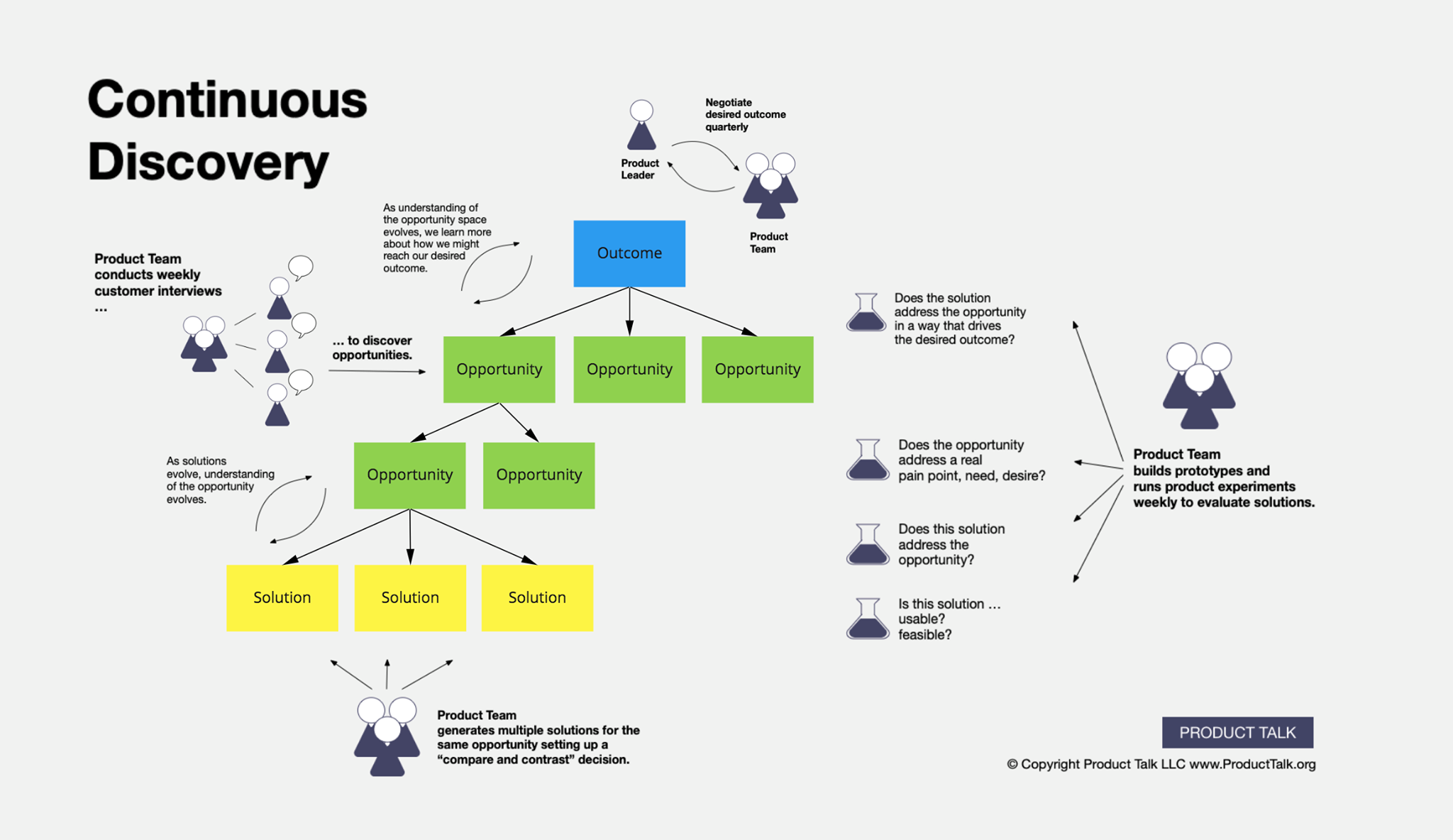
Navigating the intricate web of potential solutions for your product can be overwhelming, but the Opportunity Solution Tree Framework provides a visual aid to help product teams connect the dots. These structured diagrams, known as Opportunity Solution Trees (OSTs), link desired outcomes, key opportunities, and possible solutions, guiding your team’s focus and decision-making. Utilizing an opportunity solution tree template can further streamline this process, ensuring consistency and clarity across your team’s efforts.
OSTs, with their visual representation of the product planning process, encourage teams to dive into the opportunity space, pinpoint solutions, and chart the optimal path to goal attainment.
Origins of Opportunity Solution Trees
The brainchild of product discovery coach Teresa Torres, OSTs were introduced in 2016 as a means to help product teams effectively prioritize opportunities and create valuable solutions. Born from her experiences in training product teams, Torres recognized the need for a visual structure to guide discovery efforts, compare proposed solutions against identified customer pains, and ensure acceptance from various departments.
From the time of their inception, companies worldwide have integrated OSTs into their continuous discovery processes, enhancing the efficiency and effectiveness of product teams amidst the constantly shifting landscape of product discovery.
Decision tree thinking
OSTs are fundamentally rooted in decision tree thinking, a concept instrumental in structuring team’s problem-solving efforts and the key results in solution prioritization. This approach supports continuous product discovery by helping teams iterate and refine their solutions based on customer feedback and business objectives.
Agile prioritization techniques such as Opportunity Scoring and Cost of Delay, along with the 80/20 Pareto principle, can be employed by product managers to prioritize opportunities in the context of OSTs.
Key Components of Opportunity Solution Trees
OSTs are composed of four main components:
- Outcomes
- Opportunities
- Solution ideas
- Tests or experiments
Starting with a clear desired outcome, the tree branches out to identify key opportunities that align with customer needs and business objectives.
From there, teams can start brainstorming ideas for potential solutions, ensuring they align with both customer pain points and the overall goal. Finally, the process culminates in testing and validating the proposed solutions through experiments, allowing teams to iterate and refine their approach based on real-world feedback.
The Value of Opportunity Solution Trees in Product Discovery
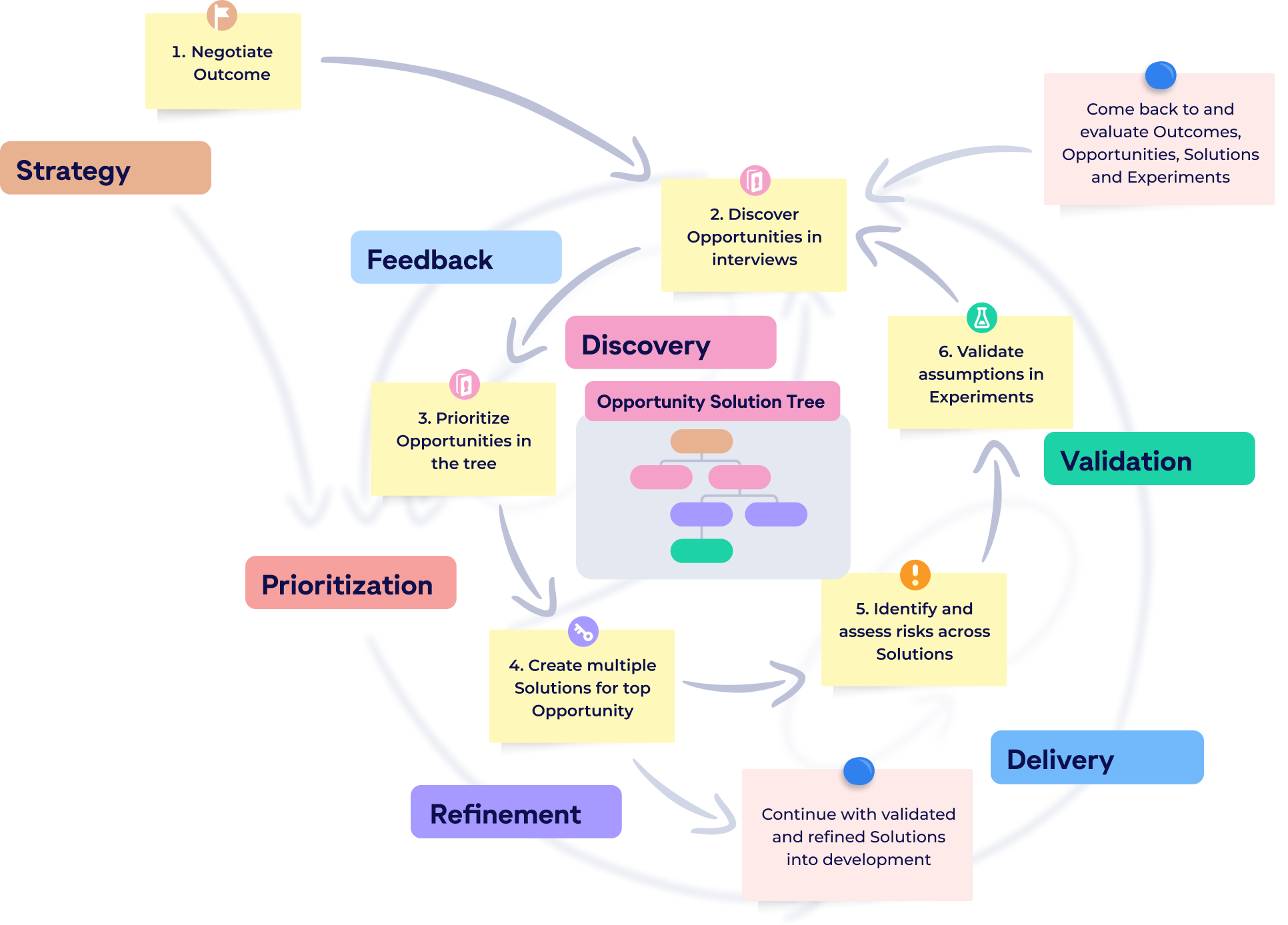
OSTs play a vital role in the product discovery process by enabling teams to prioritize opportunities based on customer needs and develop solutions that deliver value to the business. OSTs, through their visual plan, simplify the intricate process of product development and help product managers maintain an organized focus on the most urgent opportunities, thereby ensuring effective and efficient resource allocation.
Prioritizing Opportunities
In the world of product management, prioritizing opportunities is crucial to ensuring the success of your product. OSTs help teams focus on the most impactful solutions, avoiding the pitfalls of wasted resources on less effective ideas.
With the use of agile prioritization techniques and adherence to the 80/20 Pareto principle, product teams can channel their efforts towards the most urgent opportunities, leading to improved business outcomes.
Developing Solutions that Deliver Value
OSTs not only help product teams generate and identify opportunities, but they also enable the development of solutions that deliver value to both customers and the business. By aligning solutions with customer pain points and business objectives, product teams can create solutions that truly resonate with their target audience and drive meaningful results.
This iterative approach to the product development process allows teams to test and validate their ideas, refining them based on feedback and ensuring they deliver the most value possible.
Product Discovery Process

Product discovery is a critical phase in the product development lifecycle. It involves understanding customer needs, identifying opportunities, brainstorming potential solutions, and testing these solutions to validate their effectiveness. The ultimate goal of this process is to develop products that deliver genuine value to customers and meet business objectives.
Opportunity Solution Trees (OSTs) play a pivotal role in the product discovery process. They provide a visual, structured framework that enables product teams to navigate the complex landscape of opportunities and develop meaningful solutions. Starting with a clear desired outcome, OSTs branch out to map key opportunities and potential solutions, guiding the team's focus and decision-making process.
In essence, OSTs serve as a roadmap for product discovery. They allow teams to visualize the path from customer needs to effective solutions, helping them prioritize opportunities and align their efforts with customer pain points and business goals. Through the use of OSTs, product teams can streamline their product discovery process and ensure that they are developing solutions that truly resonate with their target audience and contribute to the success of the business.
Creating Your Own Opportunity Solution Tree
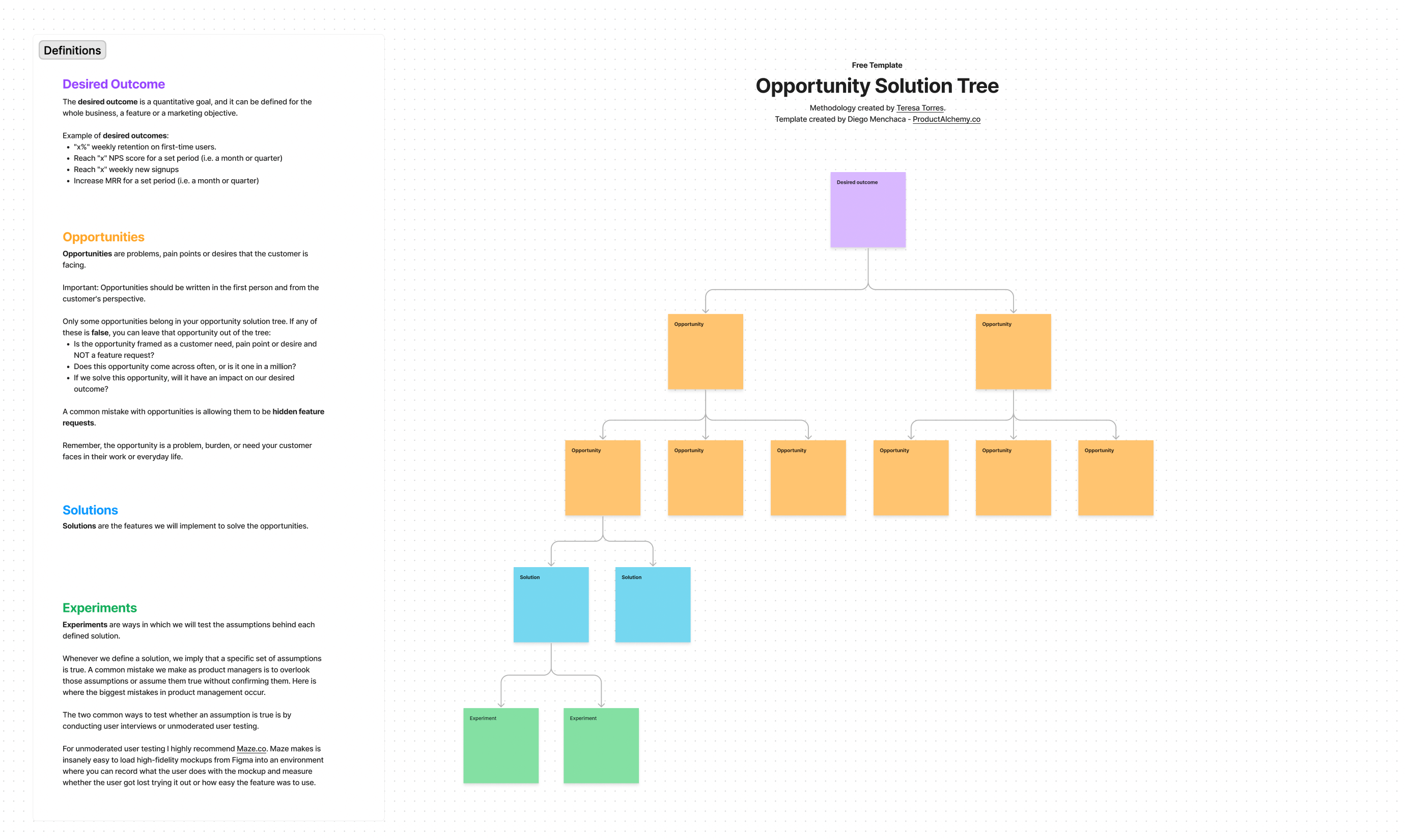
Curious about how to create your own OST? Here's a perfect Figma template to get started:

The process involves four primary steps.
- Identifying desired outcomes
- Mapping opportunities
- Brainstorming solutions
- Testing and validating solutions.
Adopting this structured approach allows your team to create a thorough visual representation of the product discovery process, aiding in the identification and prioritization of key opportunities and solutions.
Identifying Desired Outcomes
The first step in creating an OST is to determine customer need for a singular product result that is consistent with business objectives and can be influenced by the product team. Focusing on a single desired outcome ensures clarity of purpose and helps guide the team’s efforts towards addressing the most pressing customer needs and pain points.
This outcome should be aligned with both customer requirements and business objectives, ensuring a well-rounded approach to product discovery.
Mapping Opportunities
Next, map customer pain points to opportunities within the OST, concentrating on those that are in line with the desired result. Identifying opportunities that contribute to achieving the desired outcome equips product teams to concentrate on developing solutions that alleviate the most critical customer needs and pain points.
This process of opportunity mapping helps teams stay focused, organized and informed, allowing them to make informed decisions about the prioritization of resources and efforts.
Brainstorming Solutions
Once opportunities have been mapped, it’s time to brainstorm potential solutions. Involving stakeholders, customers, and other teams in the brainstorming process ensures a diverse range of ideas and perspectives, increasing the likelihood of identifying the most effective solutions.
By considering only those solutions that align with key opportunities, enable product teams can focus their efforts on creating solutions that address the most pressing customer needs and deliver the greatest customer value first.
Testing and Validating Solutions
The final step in the OST process is to test and validate the final solution or ideas through experimentation. Performing tests and analyzing the results helps product teams ascertain the most viable solutions and make necessary iterations.
This ensures that resources are used effectively and that risk is minimized, ultimately leading to the development of solutions that deliver the most value to both customers and the business.
Real-World Examples of Opportunity Solution Trees in Action
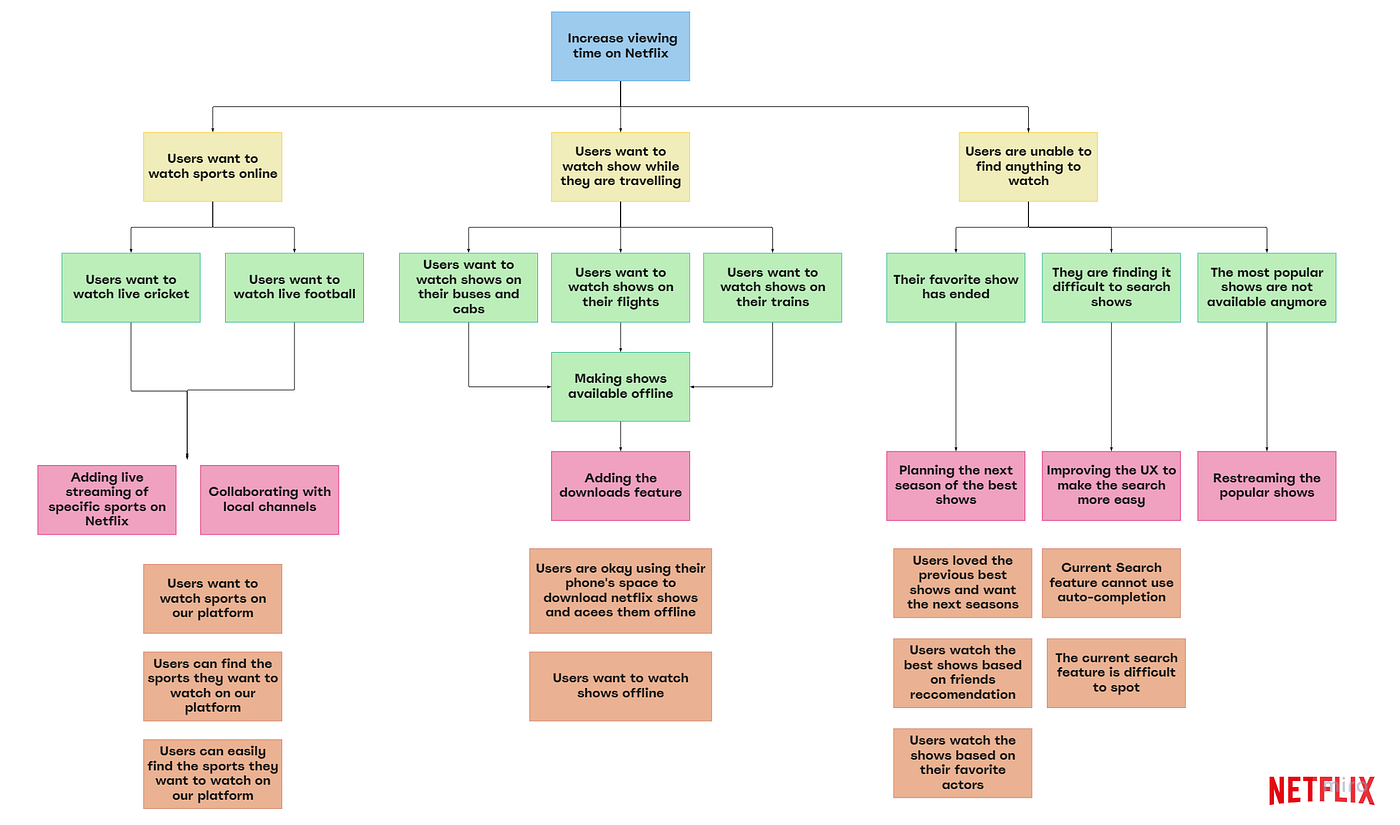
Ready to see OSTs in action? Let’s explore two real-world examples that demonstrate the power of OSTs in driving meaningful change and improvement.
In both cases, OSTs were used to identify key opportunities, prioritize efforts, and develop solutions that deliver value to customers and the business.
Case Study: Improving an Internal Product Community
Liz Lehtonen, a product manager at Wayfair, utilized OSTs to enhance the company’s global product community. By mapping out customer pain points and identifying key opportunities for improvement, Lehtonen was able to develop a product strategy, that focused on addressing the most pressing needs of the product community.
As a result, she created a template for other product managers to use in their own discovery efforts, showcasing the power of OSTs to drive impactful change within an organization.
Case Study: Rethinking Career Trajectory
Jenny Greenstein, another Wayfair employee, turned to OSTs to reevaluate her career path within the company. By mapping out different career paths and opportunities available to her, Greenstein was able to identify areas of growth and development that aligned with her personal goals and aspirations.
This allowed her to make informed decisions about her career trajectory and develop a plan for success, demonstrating the versatility of OSTs in not only product discovery but also personal development.
Best Practices for Implementing Opportunity Solution Trees

To make the most of OSTs in your product discovery efforts, it’s important to follow some best practices. These include engaging stakeholders in the problem-solving process and adapting the Opportunity Solution Tree to fit the unique needs of your customer research team.
Incorporating stakeholders in the problem-solving process guarantees the OST.
Engaging Stakeholders
The involvement of stakeholders in the OST process guarantees a plethora of ideas and perspectives, thereby boosting the chances of uncovering the most effective solutions. Engaging stakeholders, which include cross-functional partners and customers, in the problem-solving process allows you to utilize their unique insights experiment ideas and experiences, aiding in identifying and prioritizing key opportunities.
This collaborative approach not only helps to generate more ideas, but also fosters a deeper understanding of customer needs and business objectives, ultimately leading to more effective solutions.
Adapting the Opportunity Solution Tree

Tailoring the OST to meet your team’s specific needs is pivotal for preserving its sustained relevance in the product discovery process. Consider using color coding, community voting, or other methods to adapt the OST to your specific context and requirements.
By tailoring the OST to your team’s objectives, you can ensure that it remains a valuable tool for identifying and prioritizing opportunities and developing solutions that deliver business value.
Summary
The journey of product discovery is filled with intricate paths and complex decision points, but Opportunity Solution Trees illuminate the way. By adopting this powerful framework, product teams can transform how they navigate opportunities, align efforts, and deliver value.
Though OSTs originated just a few years ago, their impact has already been far-reaching, enhancing organizational communication, structuring discovery, and driving results. Companies worldwide have integrated OSTs into their roadmaps, propelling their product efforts forward with clarity of purpose.
Yet, the opportunity to utilize OSTs to their full potential still lies ahead. As more teams fine-tune their approaches, share learnings, and uncover new applications, the true capabilities of this methodology will continue to unfold.
Product managers now hold the key to unlock their team’s highest level of performance. By embracing Opportunity Solution Trees and the visual wisdom they impart, we can transform complex decision journeys into focused, streamlined paths to innovation.
With OSTs guiding the way, product teams will drive forward with their compass set on customer-inspired solutions that deliver genuine value.
The opportunity awaits.
Frequently Asked Questions
Where can I read more about continuous discovery habits?
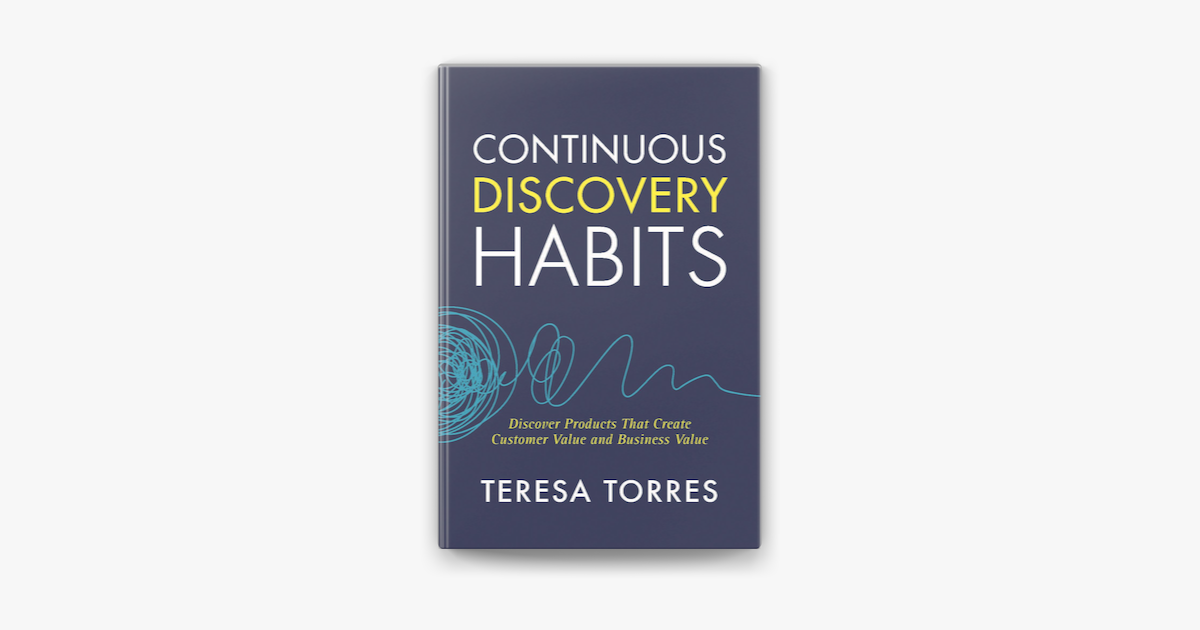
What is an opportunity solution tree?
An Opportunity Solution Tree (OST) is a visual aid that assists with the product discovery process, helping to plan out opportunities and generate ideas for reaching a desired outcome.
It overcomes common pitfalls in the product discovery phase by explicitly mapping out our opportunities.
How do you write an opportunity solution tree?
To write an opportunity solution tree example, first identify the desired outcome and opportunities then generate and experiment with solutions.
Prioritize them in a tree structure with stakeholders to test and iterate the solutions until the desired outcome is achieved.
What is the difference between Opportunity Discovery and Solution Discovery?
Opportunity Discovery focuses on identifying user problems or opportunities, while Solution Discovery uses that information to validate solutions and identify the best solution.
How do Opportunity Solution Trees help product teams?
Opportunity Solution. Trees provide product teams with a structured approach to product planning, helping them visualize the opportunities and solutions for their product, thereby enabling better decision-making.
What are the key components of an Opportunity Solution Tree?
An Opportunity Solution Tree (OST) is composed of four main components: outcomes, opportunities, solution ideas, and tests or experiments to evaluate them.


